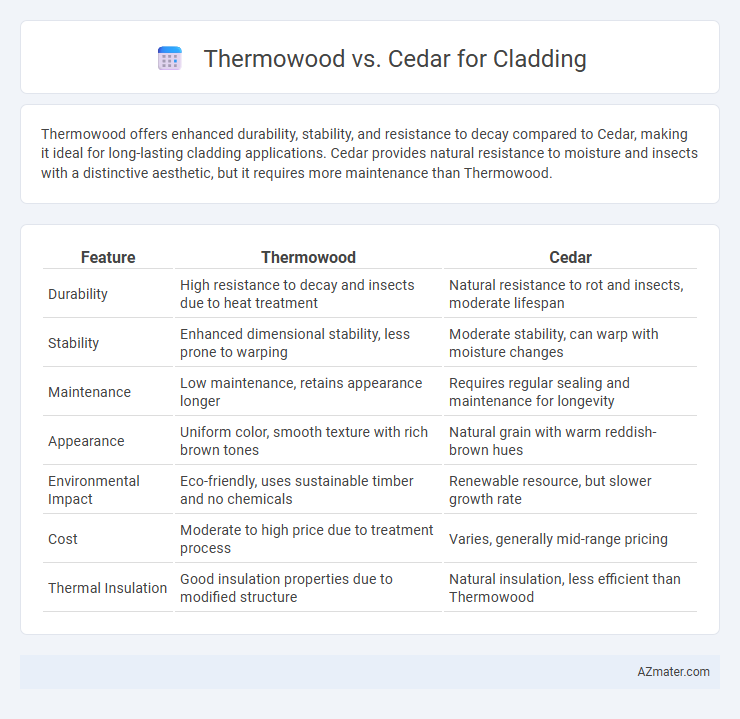Thermowood offers enhanced durability, stability, and resistance to decay compared to Cedar, making it ideal for long-lasting cladding applications. Cedar provides natural resistance to moisture and insects with a distinctive aesthetic, but it requires more maintenance than Thermowood.
Table of Comparison
| Feature | Thermowood | Cedar |
|---|---|---|
| Durability | High resistance to decay and insects due to heat treatment | Natural resistance to rot and insects, moderate lifespan |
| Stability | Enhanced dimensional stability, less prone to warping | Moderate stability, can warp with moisture changes |
| Maintenance | Low maintenance, retains appearance longer | Requires regular sealing and maintenance for longevity |
| Appearance | Uniform color, smooth texture with rich brown tones | Natural grain with warm reddish-brown hues |
| Environmental Impact | Eco-friendly, uses sustainable timber and no chemicals | Renewable resource, but slower growth rate |
| Cost | Moderate to high price due to treatment process | Varies, generally mid-range pricing |
| Thermal Insulation | Good insulation properties due to modified structure | Natural insulation, less efficient than Thermowood |
Introduction to Thermowood and Cedar Cladding
Thermowood cladding undergoes a heat treatment process that enhances its durability, stability, and resistance to decay, making it an eco-friendly option for exterior siding. Cedar cladding, known for its natural oils and tight grain, offers excellent weather resistance and a warm, rich appearance that ages gracefully over time. Both materials provide sustainable solutions for building facades, with Thermowood offering improved dimensional stability and Cedar delivering inherent rot resistance and aesthetic appeal.
Origins and Sustainability of Materials
Thermowood originates from sustainably managed Nordic forests, where heat treatment enhances its durability and resistance without added chemicals, making it an eco-friendly cladding option. Cedar, primarily sourced from Western North America, is naturally resistant to decay and insects, with many suppliers committed to sustainable forestry certifications such as FSC. Both materials offer renewable wood solutions, but Thermowood's chemical-free modification process emphasizes environmental responsibility and longevity in exterior applications.
Durability and Lifespan Comparison
Thermowood and Cedar both offer excellent durability for cladding, with Thermowood undergoing heat treatment that enhances its resistance to decay, insects, and moisture. Cedar naturally contains oils that provide strong resistance to rot and weathering, yet Thermowood's thermal modification process extends its lifespan by making it more dimensionally stable and less prone to warping. On average, Thermowood cladding lasts 25-30 years with minimal maintenance, while Cedar can last around 20-25 years, though its longevity depends more heavily on environmental conditions and care.
Resistance to Weather and Moisture
Thermowood offers superior resistance to weather and moisture due to its heat treatment process, which reduces wood's hygroscopicity and increases dimensional stability, making it less prone to warping and decay compared to untreated cedar. Cedar naturally contains oils and extractives that provide good resistance to moisture and decay, but it may still require regular maintenance to prevent weathering effects over time. For long-term cladding applications in harsh climates, Thermowood's enhanced durability and reduced moisture absorption make it a more resilient choice against weather exposure.
Maintenance Requirements
Thermowood cladding requires minimal maintenance due to its enhanced durability from heat treatment, which reduces moisture absorption and resistance to decay, making it ideal for long-lasting exterior surfaces. Cedar cladding demands more frequent upkeep, including regular sealing or staining, to protect against weathering, UV damage, and potential insect infestations. Choosing Thermowood can significantly reduce maintenance costs and effort compared to cedar, especially in harsh climates.
Aesthetic Differences: Color and Texture
Thermowood cladding features a rich, warm brown hue that deepens over time, offering a consistent and smooth surface with subtle grain patterns, while cedar displays a natural reddish-brown tone with more pronounced knots and varied grain textures, lending a rustic and organic appearance. The thermal modification process of Thermowood enhances durability and gives it a uniform color that resists fading, whereas cedar's color naturally weathers to a soft gray if left untreated. Selecting between these materials depends on the desired aesthetic: Thermowood for sleek, modern exteriors and cedar for a traditional, textured look.
Thermal and Insulation Properties
Thermowood offers superior thermal stability and enhanced insulation properties due to its heat treatment process, which reduces moisture content and improves dimensional stability. Cedar naturally provides excellent insulation with its low thermal conductivity and inherent resistance to moisture and decay, making it an energy-efficient option for cladding. Both materials contribute to energy efficiency, but Thermowood's modified structure provides more consistent thermal performance in varying weather conditions.
Environmental Impact and Certifications
Thermowood cladding, produced through heat treatment of sustainably sourced softwoods, significantly reduces chemical use and enhances durability while maintaining a lower carbon footprint compared to traditional treatments. Cedar cladding, naturally resistant to decay and insects, often carries Forest Stewardship Council (FSC) certification, ensuring responsible forest management and minimal environmental impact. Choosing FSC-certified Thermowood or Cedar supports sustainable forestry practices and reduces ecological damage associated with deforestation and chemical preservatives.
Cost Analysis: Upfront and Long-term
Thermowood cladding generally has a higher upfront cost compared to cedar due to its specialized heat treatment process, which increases durability and dimensional stability. Over the long term, Thermowood requires less maintenance and exhibits enhanced resistance to decay and insects, resulting in lower repair and replacement expenses. Conversely, cedar's initial affordability is offset by its susceptibility to weathering and pests, necessitating more frequent upkeep and potentially higher lifetime costs.
Which is Best for Your Project?
Thermowood offers superior durability and resistance to weather due to its heat-treated process, making it ideal for long-lasting cladding with low maintenance. Cedar provides natural resistance to decay and insects, along with a distinctive warm appearance that many homeowners prefer for aesthetic appeal. Choosing the best option depends on your project's environmental exposure, budget, and desired visual style, with Thermowood excelling in harsh climates and Cedar favored for traditional beauty.

Infographic: Thermowood vs Cedar for Cladding
 azmater.com
azmater.com